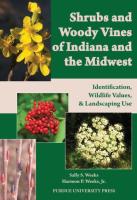Description
As the definitive identification guide to the shrubs and woody vines of Indiana, this book also provides coverage of 90% of the species to be found in surrounding Midwestern US states. As well as covering indigenous species, it also includes all currently known invasive shrubs. Written by two leading experts in plant taxonomy, the guide is prepared in the same attractive, easy-to-use format as the bestselling Native Trees of the Midwest. Descriptive text explains how to identify every species in any season, and original color photographs taken by Sally Weeks detail all important characteristics. The authors provide practical guidance concerning the potential ornamental value of each species for those interested in landscaping and also evaluate their potential value for encouraging wildlife. Designed for experts in natural resource management as well as the interested general public, the volume includes distribution maps, identification keys, and an index of both common and Latin names.
Last updated on
Product Details
- Purdue University Press Brand
- Mar 15, 2012 Pub Date:
- 9781557536105 ISBN-13:
- 1557536104 ISBN-10:
- 475 Pages
- English Language
- 9.5 in * 6.6 in * 1.1 in Dimensions:
- 3 lb Weight:




